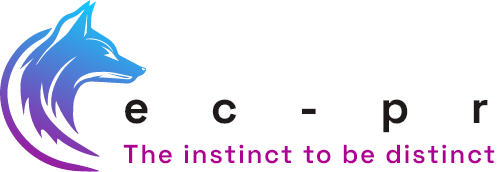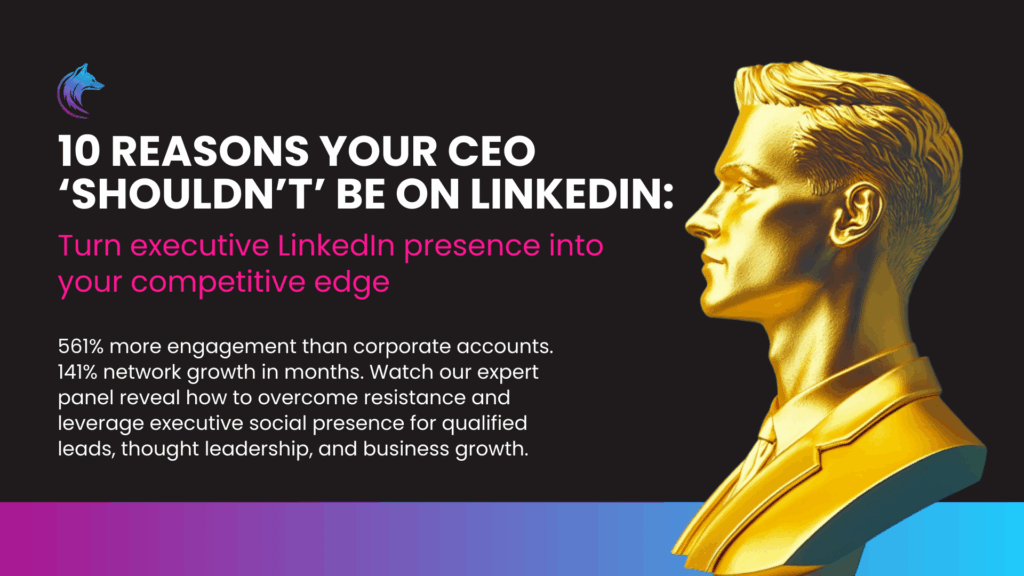
Thought leadership content: what works in 2025?
Thought leadership content has become a driving force in today’s digital landscape. Business leaders rightly see thought leadership as a way to elevate their brands and establish authority. And PR agencies, like EC-PR, are enjoying more requests for this kind of content.
However, not all companies are aware of what they’re asking for. So, here’s a roundup of what thought leadership content works in 2025, how to generate it, what company leaders must expect to contribute, and how marketing and PR should amplify their contributions to maximise results.
1What is thought leadership content?
Thought leadership content is unique, thoughtful, and often inspirational content, generated by leaders who are both subject-matter experts in their field, and people who possess a broad perspective of their sector, its challenges, and future prospects. Thought leadership content can be in many formats, such as articles, videos and educational output and even social media posts that bestow an original viewpoint on the chosen topic.
We will explore thought leadership content examples in this article, but begin by highlighting roundtables in particular. They are a powerful medium to generate a flow of original ideas through discussion among select participants. This can feed into a waterfall of thought leadership content that achieves high-trust and low-trust media coverage, benefitting participants, sponsors and audiences.
When executed effectively and supported by whitepapers, insight articles, interviews, blogs (guest and owned) and social media, roundtables become a source of valuable insights that can feed the communication funnel for months.
Before we give more details on the how-to, a word of warning.
What thought leader content is not
- Lead generation
- A sales tactic
- Your expertise showcase
- Influencer content
I like to start with this disclaimer – let’s clarify what thought leader content is not. Contrary to common misconceptions, it is not a mere lead generation tool though it will contribute to lead-gen efforts. Neither is it a sales tactic, and if you use it in this way, it will fall flat.
Many make the mistake of thinking they should use thought leader content as an expertise showcase for their executives – that is what their LinkedIn is for! Lastly, keep your thought leadership content and influencer content separate. They can strengthen each other but not substitute each other.
Thought leadership content is about providing unique perspectives and insights that resonate with your audience, entertaining and educating, while fostering trust and authority.
3How do you know you’re ready to be a thought leader?
To embrace thought leadership, individuals and companies must evaluate their capabilities. Thought leaders are distinguished by their ability to develop and share strong, unconventional opinions. This goes beyond conventional marketing strategies; it’s about presenting a viewpoint that challenges the status quo.
Thought leadership trends in 2025
In 2024, thought leadership trends saw a shift toward bolder opinions, greater authenticity, and a demand for truly unique viewpoints. In 2025, that momentum is accelerating—these qualities are no longer optional, they’re expected.
The thought leadership trends we are seeing in 2025 include:
- Topic ownership: Instead of chasing trending themes, top thought leaders are choosing one or two big topics—and owning them across multiple platforms.
- Community-first thinking: High-performing thought leaders are fostering niche communities through events, LinkedIn Lives, and private forums.
- C-suite visibility: More executives are building personal brands that align with corporate purpose, helping brands gain both reach and credibility.
- AI transparency and human-first insight: As AI usage becomes the norm, thought leaders who openly discuss its limits—and where human expertise adds value—will lead the pack.
Staying ahead of these trends will make thought-leader content relevant and impactful. But ask yourself…
To make successful thought-leader content: Are you bold enough?
To truly lead, you will need to develop and share strong opinions, that are not mere marketing churnalism. Do you have the expertise to hold an unusual or unique viewpoint?
Know that you will be too bold sometimes.
Companies and thought leaders must be willing to express strong opinions that challenge the norm. Thought leadership is not about playing it safe but about being daring in your perspectives.
However, boldness is harder to do than it is to say. If an idea is brilliant, campaign execution must be equally so, and bold statements need extensive exposure to work.
Lessons learned through our own thought leaders’ journeys:
- Boldness requires readiness.
- Thought leadership goes far beyond marketing norms.
Examples of thought leaders in 2025
Looking at successful thought leaders across industries can provide inspiration. Individuals and companies who have effectively navigated the landscape offer insights into what makes compelling thought-leader content.
If you think of people who are stellar examples of thought leaders, a lawyer-come- Editor in Chief is well-positioned to be bold:
1. Mel Robbins
Mel Robbins is a personal growth and behavioural change thought leader. In 2025, she continues to influence millions through her podcast, speaking engagements, and viral social content. Her latest book, The Let Them Theory, has struck a chord with audiences by encouraging individuals to release control, embrace boundaries, and let others be who they are. Its currently in the Amazon top sellers list.
Companies can also be thought leaders. Consulting firms long pioneered thought leadership and I expect they will continue to do so, because they share unmatched-quality business research. Deloitte, McKinsey, or the below example of thought leadership are ones to watch:
2. 37signals (formerly Basecamp)
Founded in 1999 by Jason Fried, Carlos Segura, and Ernest Kim, 37signals began as a web design company before transitioning to focus exclusively on web applications. By 2025, the company had fully moved away from design and consultancy work to concentrate on building simple, effective software tools. Notably, the popular open-source framework Ruby on Rails was originally developed in-house at 37signals to support their own projects.
While their products are used by millions, the company’s most lasting impact may lie in how it has shaped conversations around work culture. Co-founders Jason Fried and David Heinemeier Hansson (DHH) have become thought leaders in the tech world, promoting calm, sustainable productivity and challenging conventional business norms. Their bestselling books, Rework and Remote, have influenced a generation of entrepreneurs — the former questioning traditional business rules, and the latter championing remote work long before it became mainstream.
Many of us, who spend ample time on the internet, are aware of heavy-hitting thought leaders on socail media platforms such as LinkedIn. Leaders buidling trust with their audience are garnering the most respect in 2025, such as this example of a thought leader in the social media world :
3. Matt Navara
Matt Navara is one of the most trusted voices in the social media world. As a journalist and social media industry analyst, he’s known for breaking news, sharing updates on platform changes, and giving practical tips to marketers. He’s not just talking theory — he’s deeply embedded in the day-to-day of the industry.
He does well due to his real-time updates on social media platform changes (especially Twitter/X, Instagram, LinkedIn, and TikTok). He shares leaked features, beta tools, and early access news before most others and practical advice for social media managers, brands, and creators. Plus, he runs a very active newsletter and Discord community, showing he’s in the trenches with the people using the tools.
Matt is constantly experimenting with platforms, replying to questions, and spotlighting real-world use cases. His posts on LinkedIn (and X/Twitter) are short, sharp, and actionable — perfect for busy professionals who want insights they can use immediately.
A note on thought leaders versus influencers:
These two groups are distinct.
An influencer can, technically, be bought. They might also be thought leaders in their expertise, which makes them valuable influencers. However, a thought leader for your company is someone who shares insights without sales speak, discount codes, or any marketing plugs. Think insights, all the time.
4Challenges of being a thought leader
While thought leadership offers numerous benefits, we’ve mentioned the difficulty of being bold, which comes naturally to few people and fewer companies. However, there are even more challenges. We help our clients overcome these “cons” of thought-leader content:
Consistently generating new perspectives
Maintaining a consistent stream of fresh perspectives is a challenge. However, it’s essential for thought leaders to stay relevant and continue capturing the audience’s attention.
The internet trolls
As a thought leader, you will face genuine criticism, as well as trolls. Managing these without a billy goat requires resilience and a focus on the bigger picture.
Effective audience filtering
Thought leaders, just like marketers, need to filter their audience effectively. While this may feel like closing yourself to potential leads, reducing your target audience allows you to relate more deeply and be more memorable to an appropriate following. Remember, a streak of tigers is better than the largest gaggle of geese.
5How to get started as a thought leader
Embarking on the thought leadership journey involves strategic planning and execution:
Research internal sentient, before researching competitors
Understanding your internal capabilities and strengths is the first step. Poll or survey your executives to identify unique perspectives and potential areas where you can provide unexpected insights that truly qualify as thought leadership. You’re not looking for sheep, you’re looking for wolves.
Validate which opinions are new and in-line with your branding
Validate which opinions are both new and innovative in a way that establishes your authority in the industry. Of these, decide which best align with your brand identity.
Plot a distribution plan to share your unique viewpoints
Having ground-breaking opinions is not enough; you need a well-thought-out distribution plan. Consider platforms like roundtables, podcasts, blogs, and social media to amplify your unique viewpoints.
6How to bring media attention to your thought leadership content
An interesting agenda will attract powerful spokespeople. The suitable themes will also compel the right audience. But gaining media attention for your thought-leader content involves strategic outreach. You’re not going after the stragglers of the herd – when it comes to media selection, you want to pitch the pack leader.
Here are the bare minimum activities that bold PR teams must carry out to attract the right attention to thought leader content:
Journalist or analyst relations
Building relationships with journalists and analysts can amplify your content’s reach. Engage with them, share insights, and establish yourself as a valuable source.
Guest posting
Contribute guest posts to reputable platforms within your industry. This not only expands your reach but also positions you as an industry authority.
Speaking opportunities
Participate in speaking opportunities, whether at conferences or webinars. Public speaking enhances your credibility and exposes your thought leadership to a broader audience.
How EC-PR approaches thought leadership content
Bold thought leadership campaigns created by EC-PR will always include building a Brilliant Ideas Bank, securing media stories, roundtable events and a Message Waterfall. This last element ensures that roundtable content is made available across multiple media types and presented in various formats.
Our pit stops include insights papers or whitepapers, a LinkedIn Live event or webinars, written blogs on-site and expert industry sources, and strategically planned social posts.
For a company in industrial minerals, for example, we generated a thought leadership campaign that put them in front of a total audience of 1.38 million people. Our press coverage averaged a domain authority of 54 too, and the nature of the delivery of the campaign gave Seequent ample slice-and-dice content for further down the line.
Seequent continues to extend the campaign’s longevity and nurture thought leadership. Shall we do the same for your brand? Get in touch!
How to become a thought leader
BEACON B2B PR Guide
Essential advice and tactics on how to do B2B Tech PR thought leadership.


